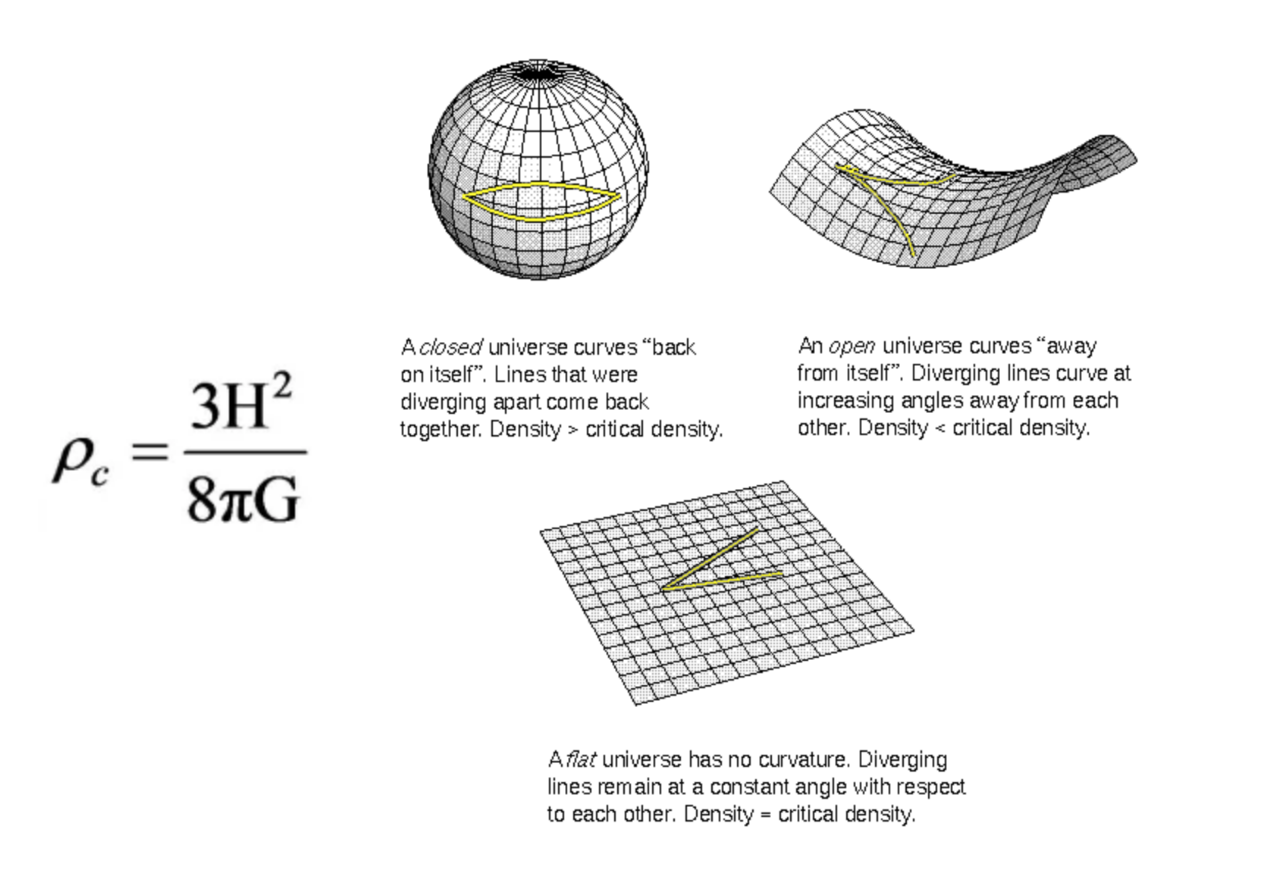Astrophysics
1/73
Earn XP
Name | Mastery | Learn | Test | Matching | Spaced |
|---|
No study sessions yet.
74 Terms
Planet Definition - 4 points
An object that orbits the sun
is not a satellite of an object
is massive enough that its own gravity forces it to be round
has cleared its neighbourhood of smaller objects around it (due to its gravity) - ruled out Pluto
Moon Definition
Natural satellite that orbits a planet - could also orbit a dwarf and minor planet (pluto has moons - dwarf)
Small Solar System Bodies Definitions
All other objects except satellites, orbiting the sun
Asteroids / minor planets definition
Small Solar System Bodies
An object that orbits the sun that isn’t a planet or comet
(e.g. Ceres and Ryugu)
Comet definition
Small solar system bodies
An object containing frozen gases, rock and dust;
When a comet nears the sun heating up causing the gases to vaporise
Produces a coma (small atmosphere) and a tail (directed away from the sun due to the solar winds)
Planetary System Definition
A set of gravitationally bound non-stellar (not stars) objects in orbit around a star/star system
Star Definition
A luminous Balls of gas, mostly hydrogen and helium, held together by its own gravity
Gravitational Equilibrium in Stars occurs when…
Nuclear fusion at the star’s core creates high pressure in the gases that counteracts the forces of gravity (creating equilibrium)
Binary System Definition
Two stars that rotate around a common centre of mass
Constellation
A configuration of stars in the night sky (viewed from earth)
Located close together that when joined by connecting lines form some sort of imagined picture.
Stellar Clusters Definition
Groups of stars that are gravitationally bound together
Two Types:
Globular Cluster
Open Cluster
Globular Clusters
Tight Group of hundreds or thousands of very old stars
Open Clusters
Less than a few hundred stars
Normally very young
Nebula Definition
Interstellar cloud of dust and gases
All stars are formed in a nebula
Galaxy Definition
A system of millions or billions of stars and their planetary, and dust and gas, held together by gravitational attraction
Galaxy Clusters Definition
A structure consisting of hundreds of thousands of galaxies, bound together by gravity
Supercluster Definition
A large group of smaller galaxy cluster;
Among the largest structures in the universe
Light year unit
ly
Distance travelled by light in one year
1 ly = 9.46x10^15m
Astronomical Unit
AU
Average distance between the sun and the Earth
1AU = 1.50x10^11
Parsec
pc
Distance of which 1AU subtends an angle of 1 arc second
Arc second → 1/3600 of 1 degree
1pc = 3.26ly = 3.09x10^16
The nature of stars
Stars depend on the equilibrium between two opposing forces. The gravitational force pushing in and the radiation and gas pressure pushing out. This is gained through nuclear fusion.

Stellar Parallax
The apparent movement of a nearby star against the distant background stars as the earth moves around the sun
p is the parallax angle
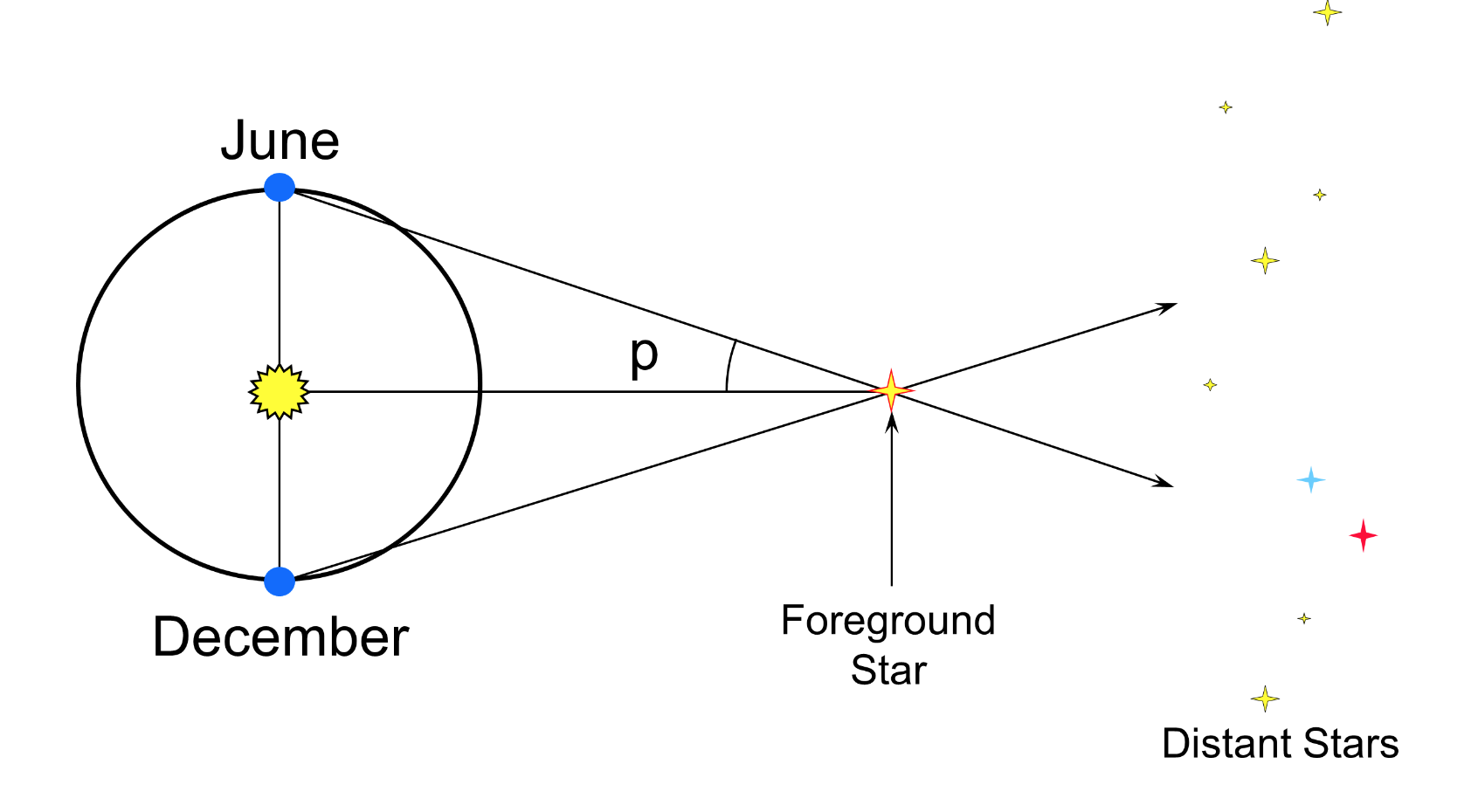
Distance to star - equation

Parallax Limitations
Parallax angles of less than 0.01 arc-seconds are difficult to resolve from Earth to the atmosphere
absorption
scattering of light
turbulence (causes to twinkle)
This limits distance measurements to 100 pc
Gaia - telescope orbiting the earth (outside atmosphere), can resolve angles to 10 micro arc-seconds (0.000010 arc-second), measuring stars up to 100 000pc
Luminosity
L
The total energy radiated by a star per second
Measured in watts
Can’t directly determine a star’s luminosity, can measure it’s apparent brightness
The more Luminous the star, the apparent brightness will be greater
b∝L
Apparent Brightness
b
Measured in watts per square metre (from earth)
How bright it appears to be
Closer = brighter
Bigger = brighter

Black-Body Definitions
Idealised absorbers of all electromagnetic radiation that falls on it, and then re-radiated.
The spectrum of the radiated energy depends on the body’s temperature
While stars aren’t perfect black-bodies, they are capable of emitting all wavelengths of EM radiation.
Follows the Stefan-Boltzman Law
Stefan-Boltzman Law
If we approximate stars as being spherical:
A=4πr^2
∴L=σ4πr^2T^4
Therefore Luminosity depends on size and temperature
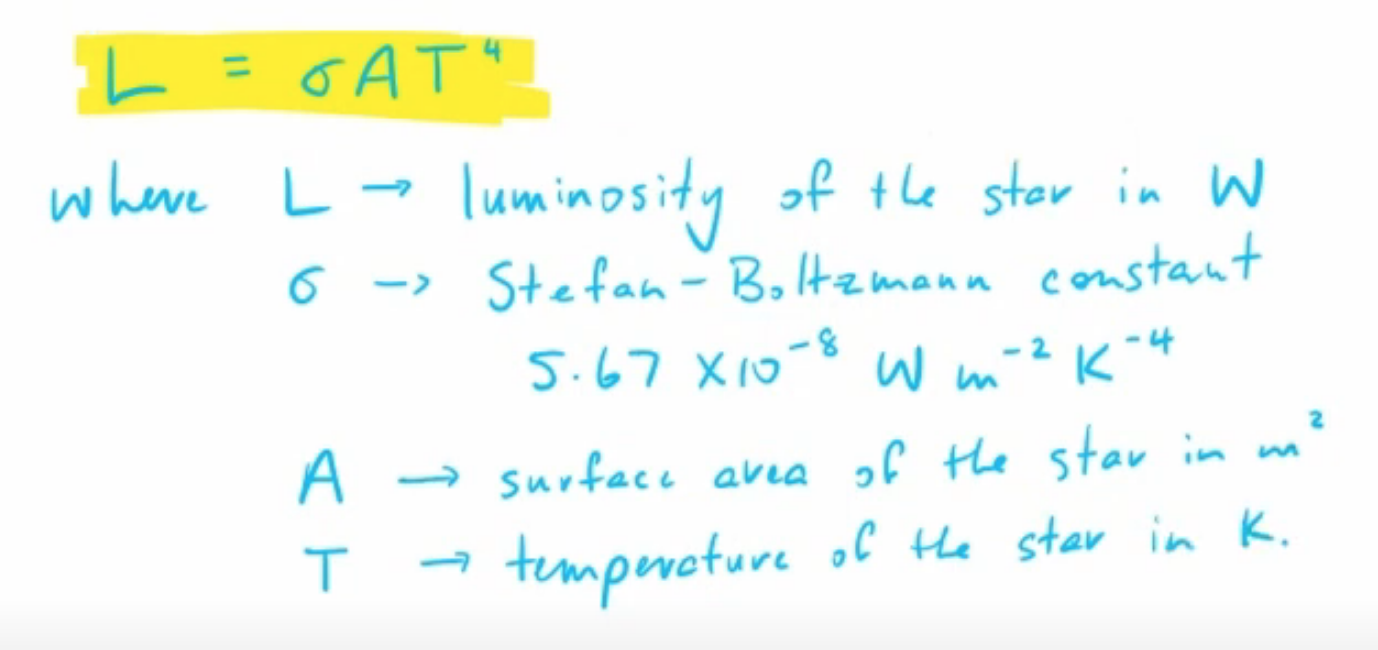
Stellar Spectra
Blue to orange/red where blue is the hottest.
Stellar Spectra Allow us to Determine:
Chemical composition - spikes or dips can be matched to known elements
Density - dips in a star’s spectrum usually relate to light from the hot dense centre of the star being absorbed by cooler, lower-density gas further out in the star.
Velocity - Using the Doppler shift/effect of the spikes in the star’s spectrum can be used to determine how fast the star is moving.
Temperature - Treating stars as Black bodies, Wein’s law can be used to relate a star’s surface temperature to the wavelength of maximum intensity in the star’s blank body radiated curve
λmax * T = 2.9x10^-3 mK → Data booklet
Cepheid Variables
Extremely luminous stars that have a periodic variation of luminosity

Relationship between the luminosity and the period of the cepheid
Linear relationship between the relative luminosity and the period of the cepheid.
This allowed measurement of the period allowed the luminosity to be determined
By measuring the apparent brightness, the distance to the cepheid variable to be determined using the equation.
Cycle of a cepheid variable star
Loss of Hydrostatic Equilibrium - the pressure inside the star is no longer able to overcome the gravitational forces leading to the outer layers of gas collapsing inwards
The layer of gas becomes compressed - less transparent (more dense) meaning the EM radiation that’s being radiated from inside the star isn’t able to escape
Temperature in the Gas layer increases - causes build-up of pressure *Intensity decreases here (you see it not as bright)
The Gas layer is pushed outwards -
The layer cools as it expands - becoming less dense
The decrease in density - radiation can now escape again as the pressure decreases *Intensity increases here (you see it brighter)
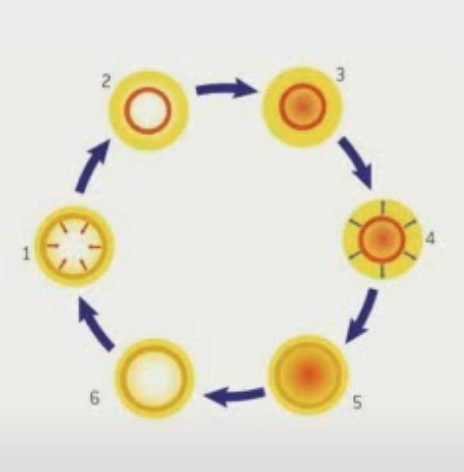
Hertzprung - Russel (HR) Diagram corner characteristics
Top right - cool & bright
Top left - Hot & bright
Bottom left - Hot & dim
Bottom Right - Cool & dim

Mass-Luminosity relation for main sequence stars
The luminosity increases with the mass
a=3.5 is commonly used for main sequence stars and doesn’t apply to red giants or white dwarfs

Main Sequence
Produce energy from fusion of hydrogen and other light elements
90% of stars are here
Red giants
Cooler than the sun;
Much more luminous - larger than the sun
Only 1% of stars are giants / super giants
Supergiants
Very large and very bright
Only 1% of stars are giants / super giants
White Dwarfs
White-ish colour
Remnants of old stars
Dead stars
Stars that have used up their fuel source so no-longer radiate their heat source
Low Luminosity - small surface area
Takes billions of years to cool down
9% of all stars
Define cosmology
The study of the universe. How it began, how it developed, and what will happen to it in the future
Olber’s Paradox
If the universe is infinite and has an infiinite number of stars then there should be no dark sky at night
Big Bang Model
Solved the Olber’s paradox. The Universe was “created” at a point about 13.8 billion years ago. It was dense and hot but is now expanding and cooling down. This is the “creation” of everything in the universe (matter, space, and time)
The everything expansion
How do we know the universe is expanding?
We know the universe is expanding because of the doppler effect on EM waves
Red shift
When the wavelength increases and the frequency decreases. The source (star) is moving away from the observer (earth). Most galaxies are seen to be moving away from the earth and away from each other. (raisin toast when baking where the raisins are the galaxies)
Blue Shift
When the wavelength decreases and the frequency increases. The source (star) is moving towards the observer (earth)

Recession Speed
A graph os a galaxy vs the distance the galaxy is from earth from cepheid variable stars. There are significant uncertainties in this data. The further away a galaxy is the faster it is receding
Hubbles Law
The current Velocity of recession, v, of a galaxy is proportional its distance d from Earth. This law can be written as:
v=Hod
Hubble’s constant, Ho
Ho = (70km) / (s x Mpc).
It is believed that this constant has changed over billions of years but is now constant
Occam’s Razor
If you need to choose between two or more possible theories then choose the one with the least amount of assumptions
Hubble Time
T ~ 1/Ho T is the age of the universe and is approximately 1.4 × 1010
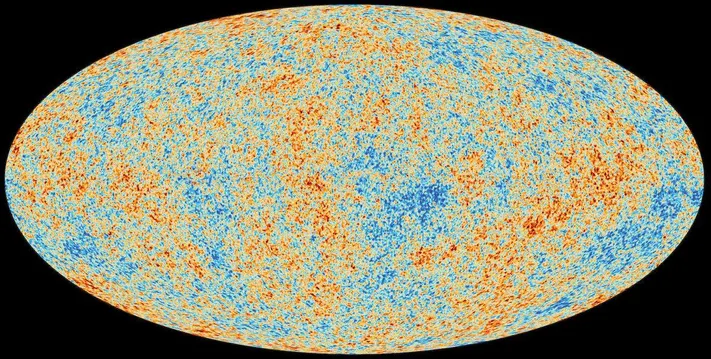
Cosmic Microwave Background (CMB) radiation
Low level microwave radiation can be detected coming almost equally from all directions (it is isotropic) rather than from a specific source. The average temperature of the universe is about 2.76K
Observable / visible Universe
The universe we can observe from earth is a sphere around us of radius 4.6 × 1010 ly
Rate of expansion of universe
It’s increasing. we know this because of red-shift from type 1a supernova
Dark Energy
A form of energy of low density but present throughout the universe
The Cosmic Scale Factor, R
Represents the size of the universe by comparing the distance between any two specified places (like two galaxies) at different times. These distances and the cosmic scale factor increase with time because the universe is expanding.
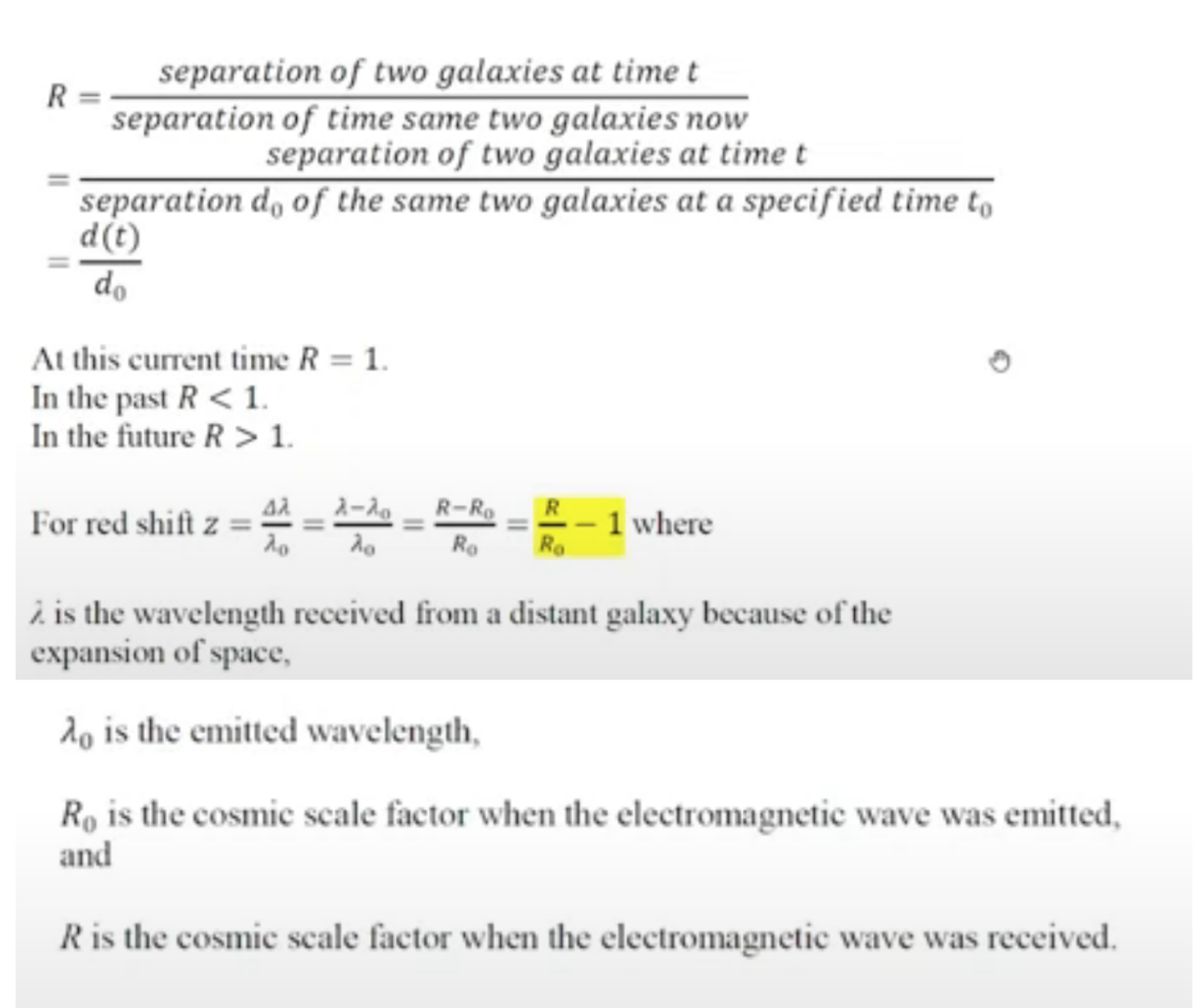
Interstellar Medium
Interstellar medium (ISM) is about is about 99% gas (mostly H and He) and 1% dust. It has a low temperature and low density. ISM is not uniform (Homogenous).
it is the region between the stars that contains vast, diffuse clouds of gases and minute solid particles
Jeans Criterion and Jeans Mass, Mj
If the gravitational potential energy of a mass of gas is higher than the kinetic energy of its molecules then it will tend to collapse.
A star cannot be formed unless the mass of the gas is greater than the critical value which is Jeans mass. Mj depends on the temperature. If the ISM is warmer that the mass necessary for the formation of a star will be higher. The collapse of an interstellar cloud to form a star can only begin if it’s mass is M.Mj
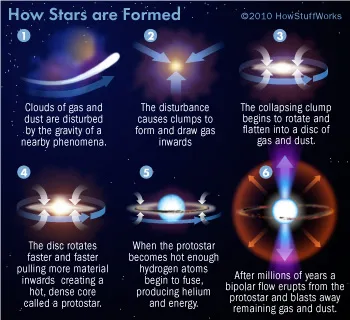
Proton-Proton cycle
This is a three step cycle for fusion in a star
Occurs to main sequence stars
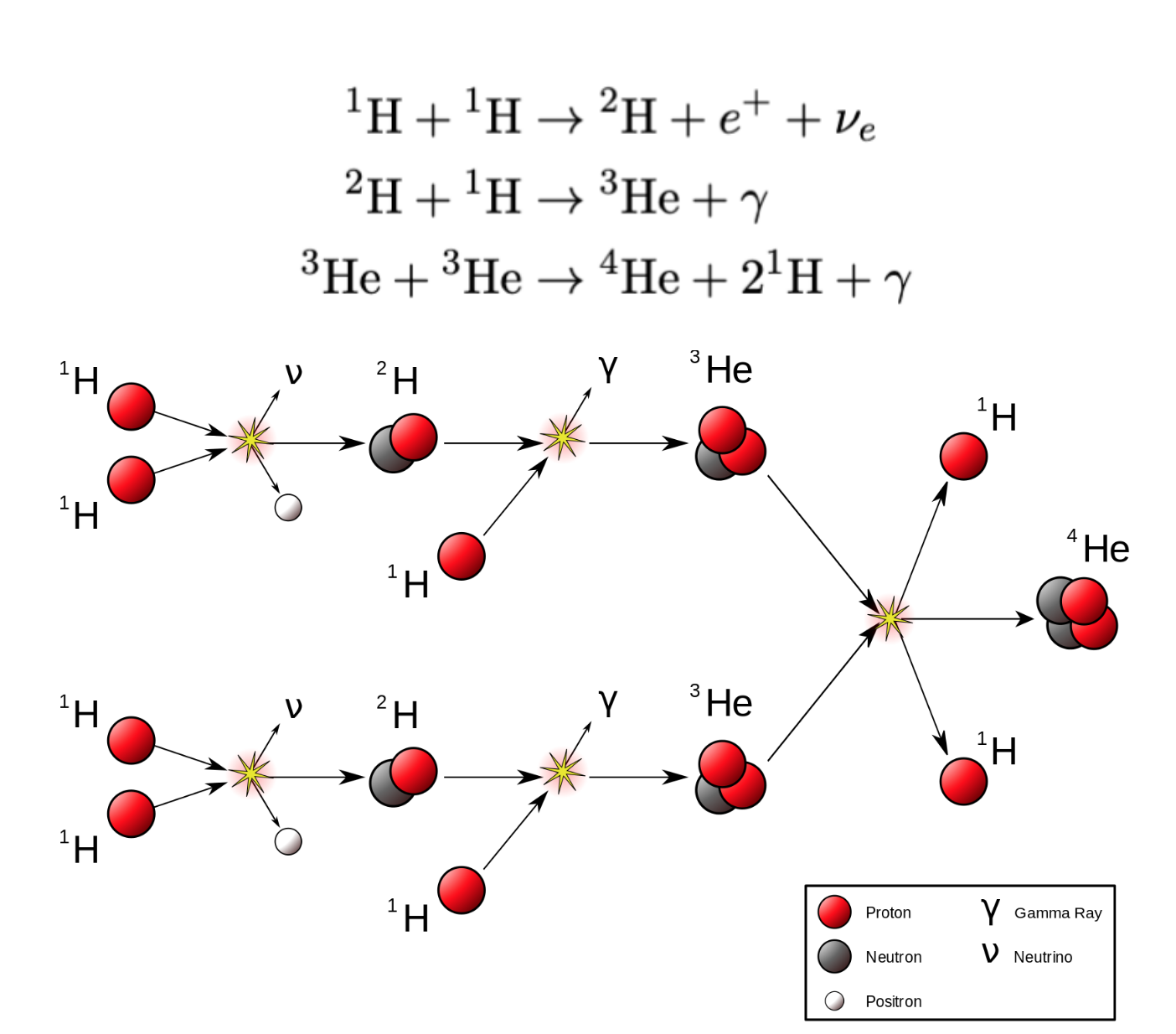
CNO Cycle
Example: the sun
Efficient at higher temperatures and becomes the dominant fusion process in stars where the core temp is above 17 × 106 K
Also in stars on the main sequence
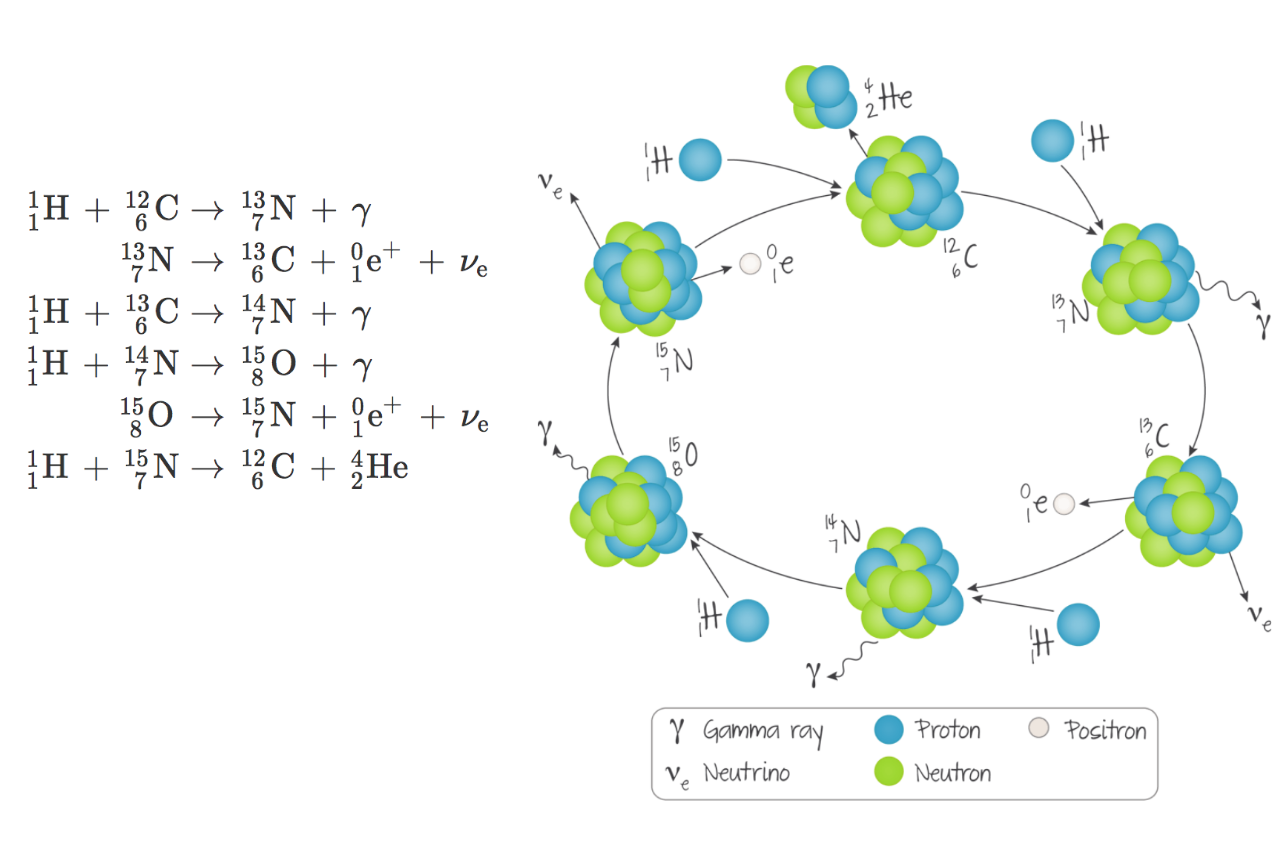
Triple-Alpha process
Occurs in the core of stars which have left the main sequence. It is the final fusion reaction for those main sequence stars with a mass smaller than eight solar masses, which end up as white dwarfs surrounded by a planetary nebula.
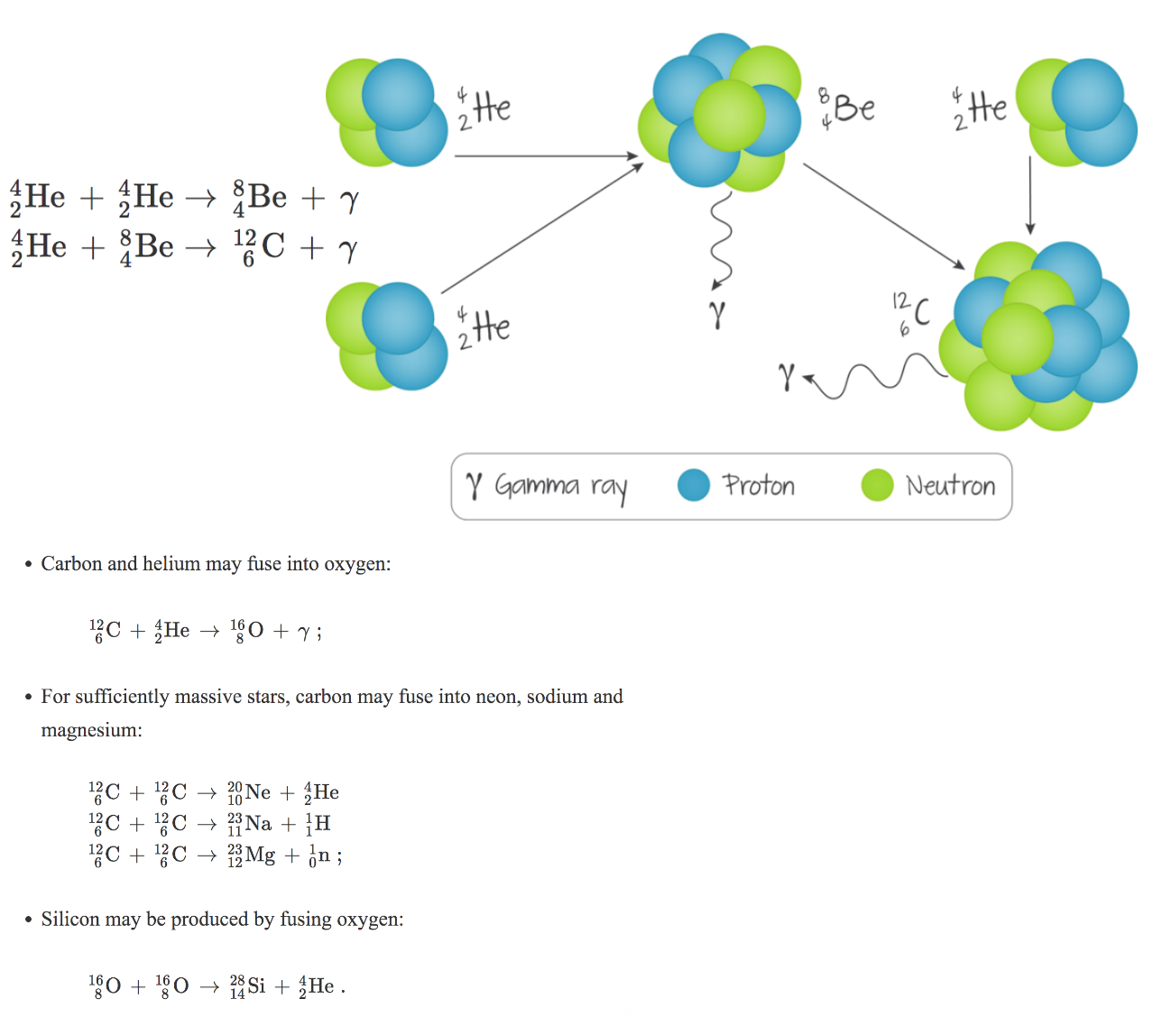

Time for a main sequence star
If the H in a star becomes depleted then the star will no longer be in equilibrium. This occurs when about 12% of the original mass of H has been fused.
The lifetime of a main sequence star depends on the original mass of H and the rate of nuclear fusion. More massive stars have more concentrated core at higher temps and deplete their hydrogen quicker.
More massive stars have shorter main sequence lifetimes. The time as a main sequence star T is proportional to the inverse of its mass m to the 2.5 power.
Lifetime of the sun
About 1010 years
Nucleosynthesis
The creation of nuclei of heavier elements by fusion
In general the contraction of the corse of main sequence stars of greater mass will result in higher temperatures, which means that the nuclei then have higher kinetic energies, so that they can overcome the larger electric repulsive forces involved in the fusion of heavier elements
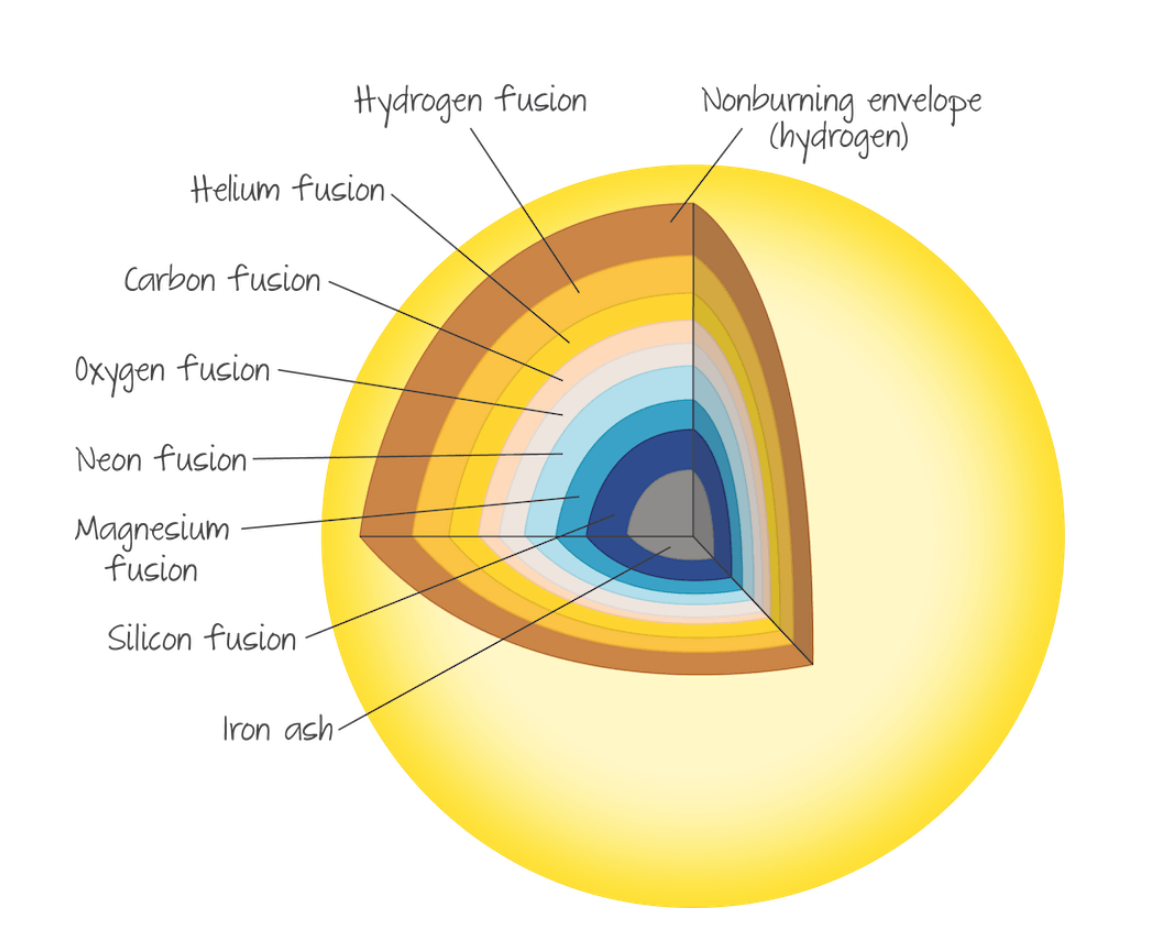

Binding Energy
Amount of energy required to separate a particle from a system of particles or to disperse all the particles of the system.
Neutron Capture
Elements heavier than iron can be formed by neutron capture. Neutrons are produced in some nuclear fusion reactions within a star. The neutrons are not charged so they can get close enough to the nuclei
After neutrons capture the new elements, the nucleus can decay by beta-negative decay.

S-Process
Slow Neutron capture occurs in red giants. This occurs over a long period of time when there is low neutron density and intermediate stellar temps. Heavier elements can be created over a long period of time. Beta decay is more likely than neutron capture.
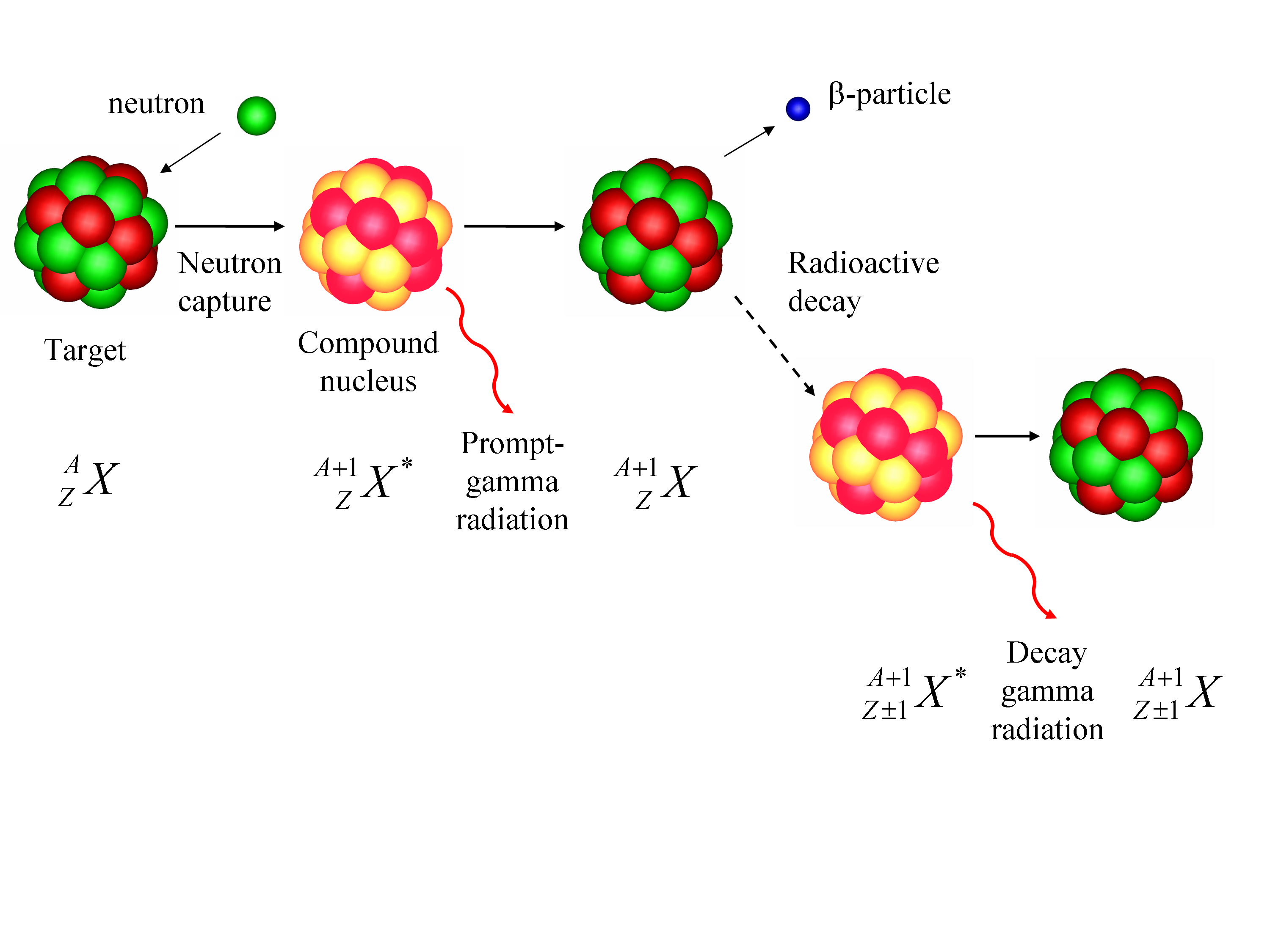
R- Process
Rapid Neutron Capture Process occurs in supernovae over a short period of time when there is a high neutron density and high stellar temperatures. Neutron capture is more likely than beta decay. More neutrons in a nucleus will lead to more beta decay and more heavier elements

Supernovae
Sudden, unpredictable and very luminous stellar explosions
Type Ia Supernovae
In a binary star system one of the stars has evolved to become a white dwarf. It’s gravitational field is now strong enough to attract matter from its neighboring star.
There is a sudden rise in mass of the white dwarf. The electron degeneracy pressure is not high enough to resist the collapse.
Type Ia supernovae can act as standard candles by using the equation
b = (L)/(4πd2)
Type II Supernovae
When nuclear reactions in a red supergiant finish, the star collapses but the mass and energy involved are so huge that the nuclei in the core get deconstructed to protons, neutrons, electrons, photons and neutrinos. The outer layer of the star is stripped. Rapid neutron capture occurs so heavier elements are created. The core becomes a neutron star or black hole
Lifetime of stars
Starts off as a stellar nebula
Then there is two paths
Path 1:
Average star
Red Giant
Planetary Nebula
White dwarf
Path 2:
Massive star
Red super giant
Supernova
Black hole or neutron star
The Cosmological Principle
The universe is homogenous - everywhere looks the same
The universe is Isotropic - no identifiable edge, everywhere the length is the same
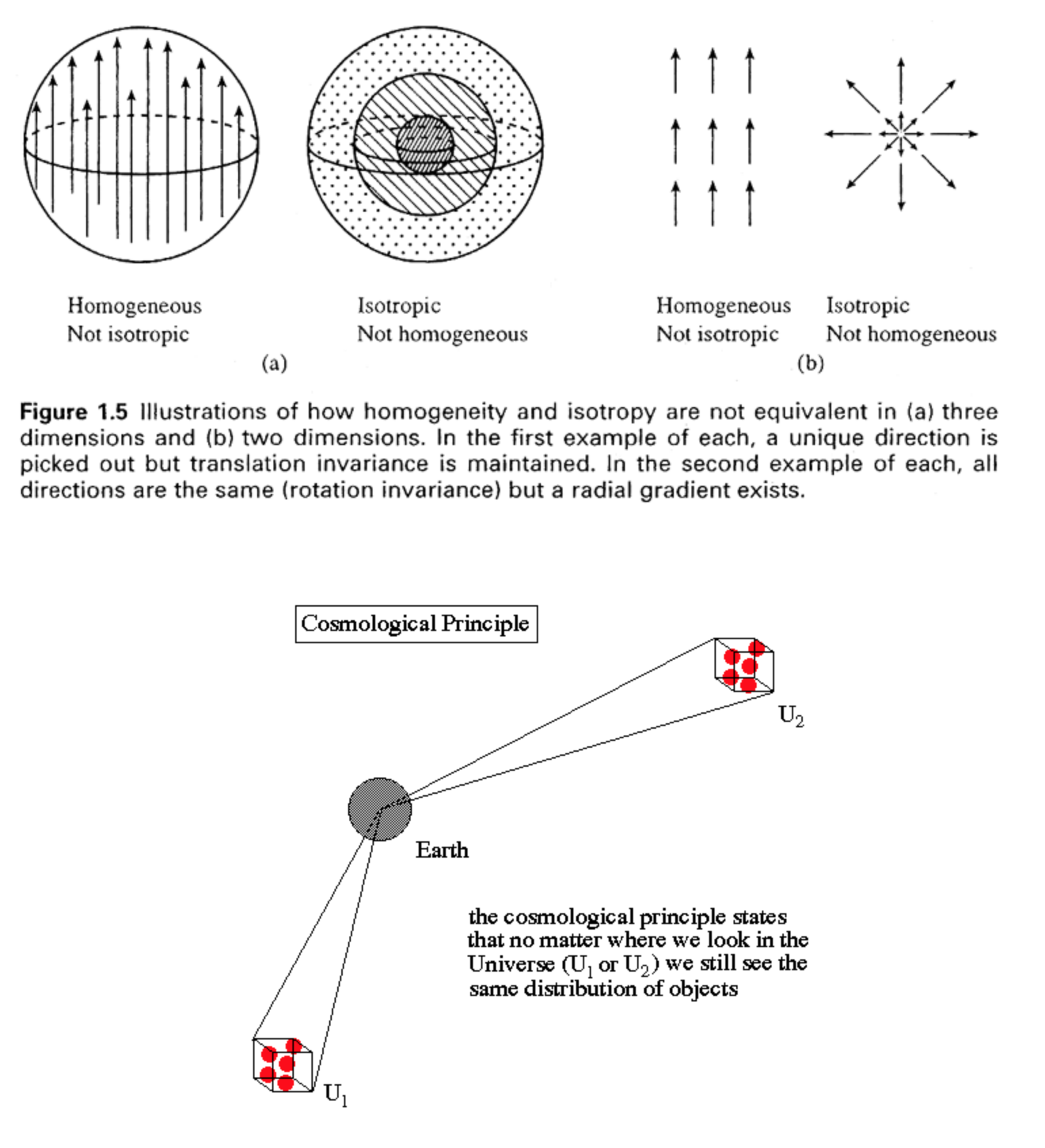
Fluctuations in the CMB
The differences in the temperature map correspond to areas of varying density fluctuations in the early universe. Eventually, gravity would draw the high-density fluctuations into even denser and more pronounced ones. After billions of years, these little ripples in the early universe evolved, through gravitational attraction, into the planets, stars, galaxies, and clusters of galaxies that we see today.
Critical density
The 'critical density' is the average density of matter required for the Universe to just halt its expansion, but only after an infinite time.
